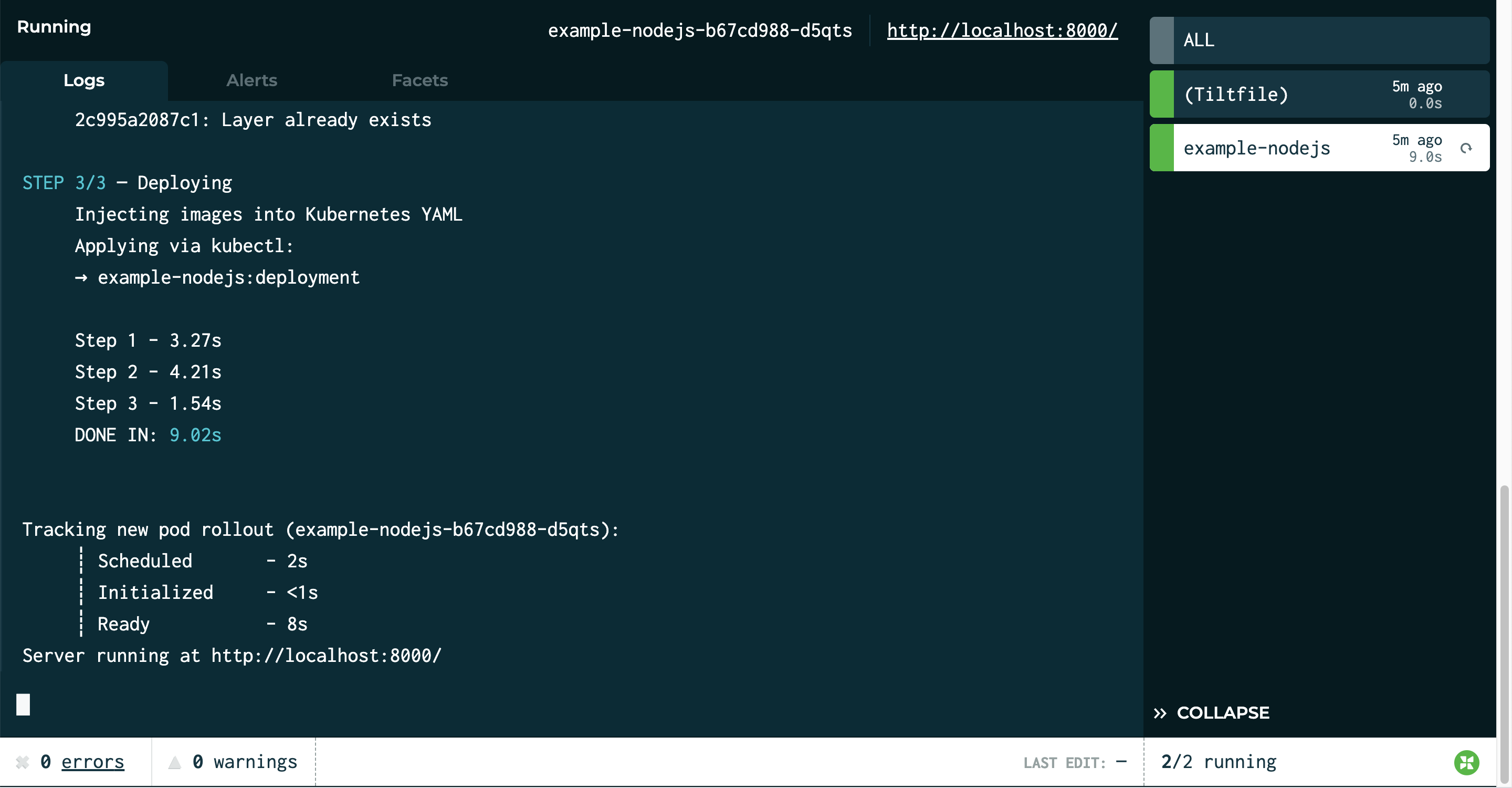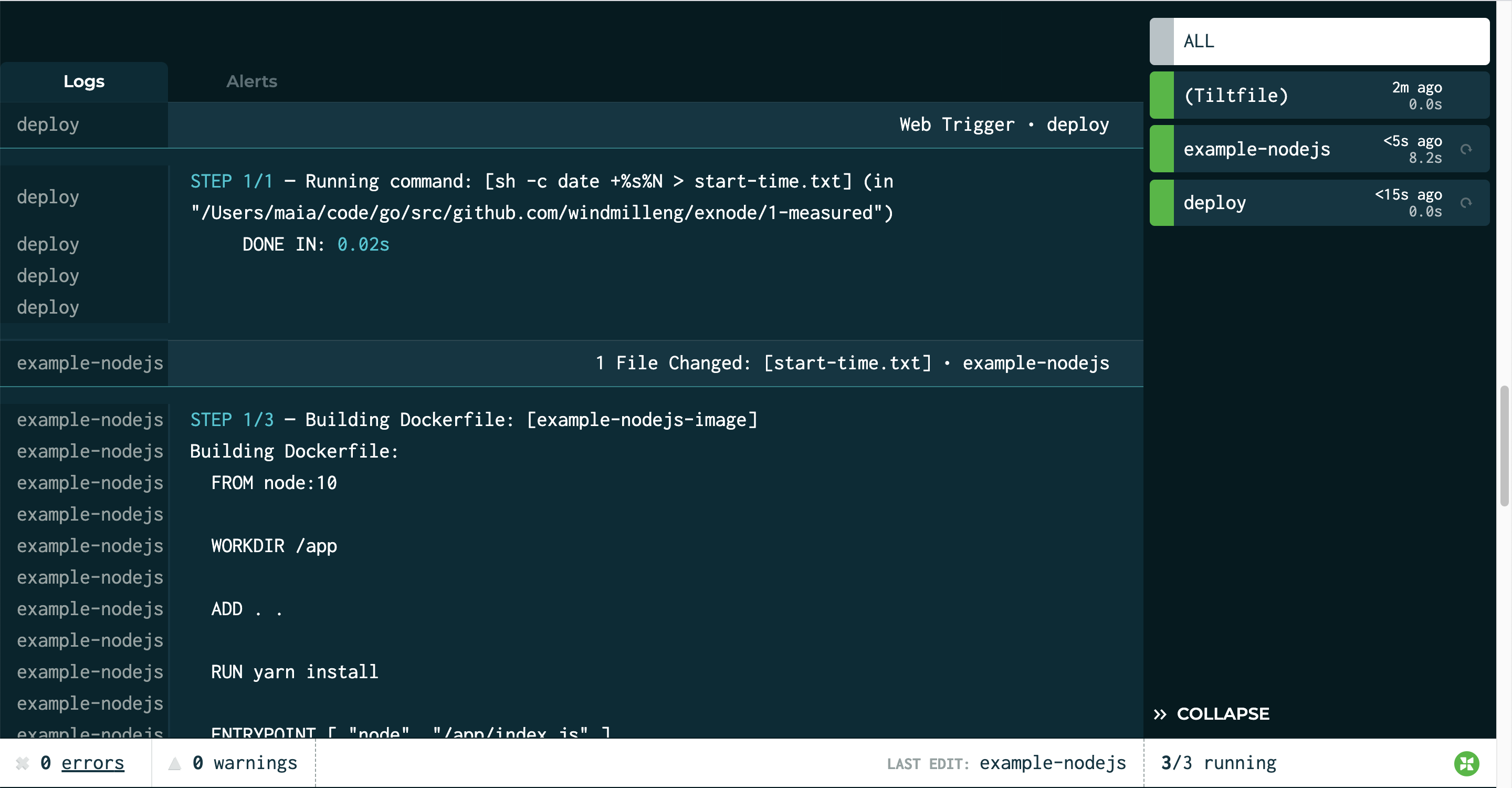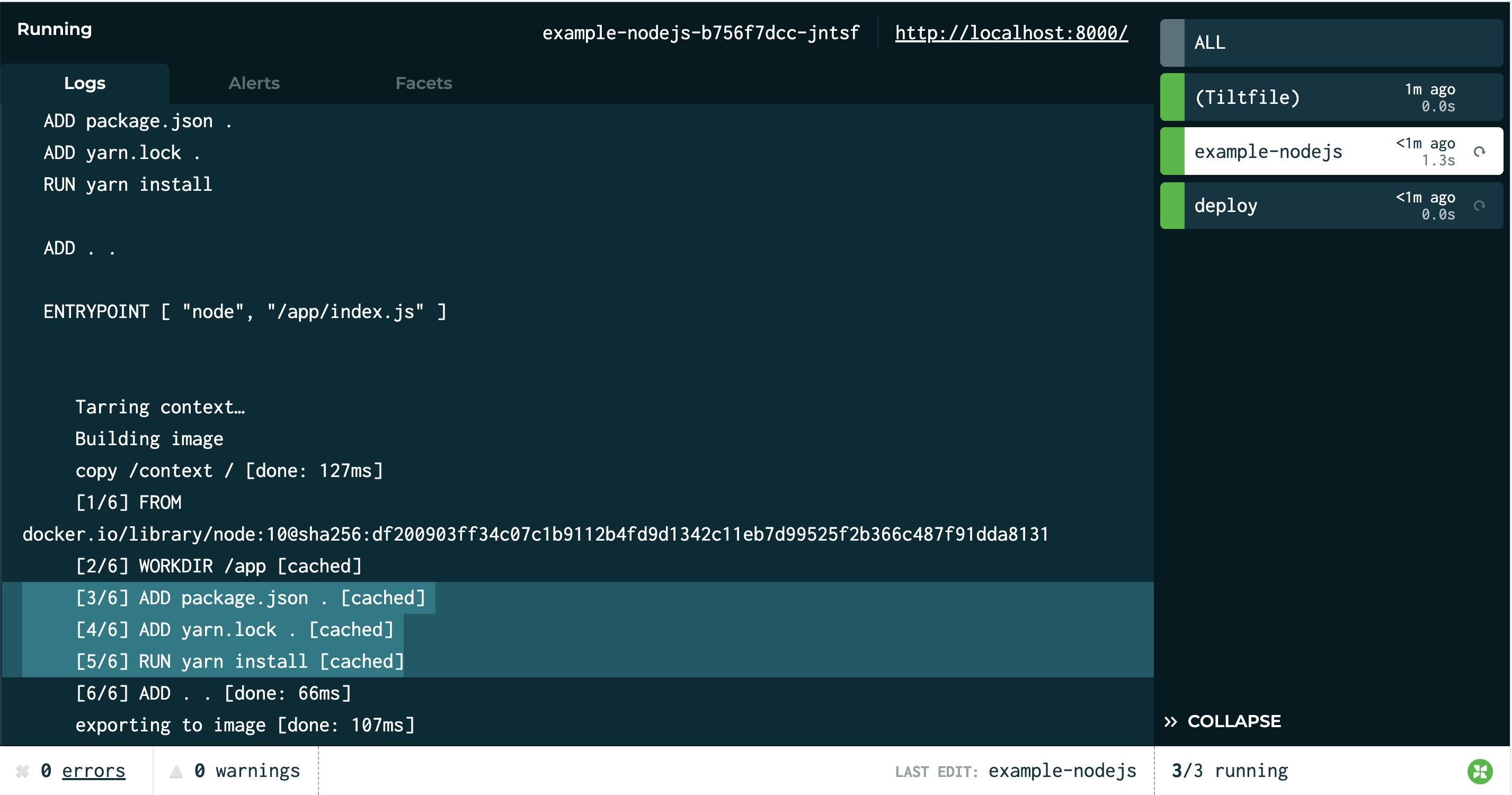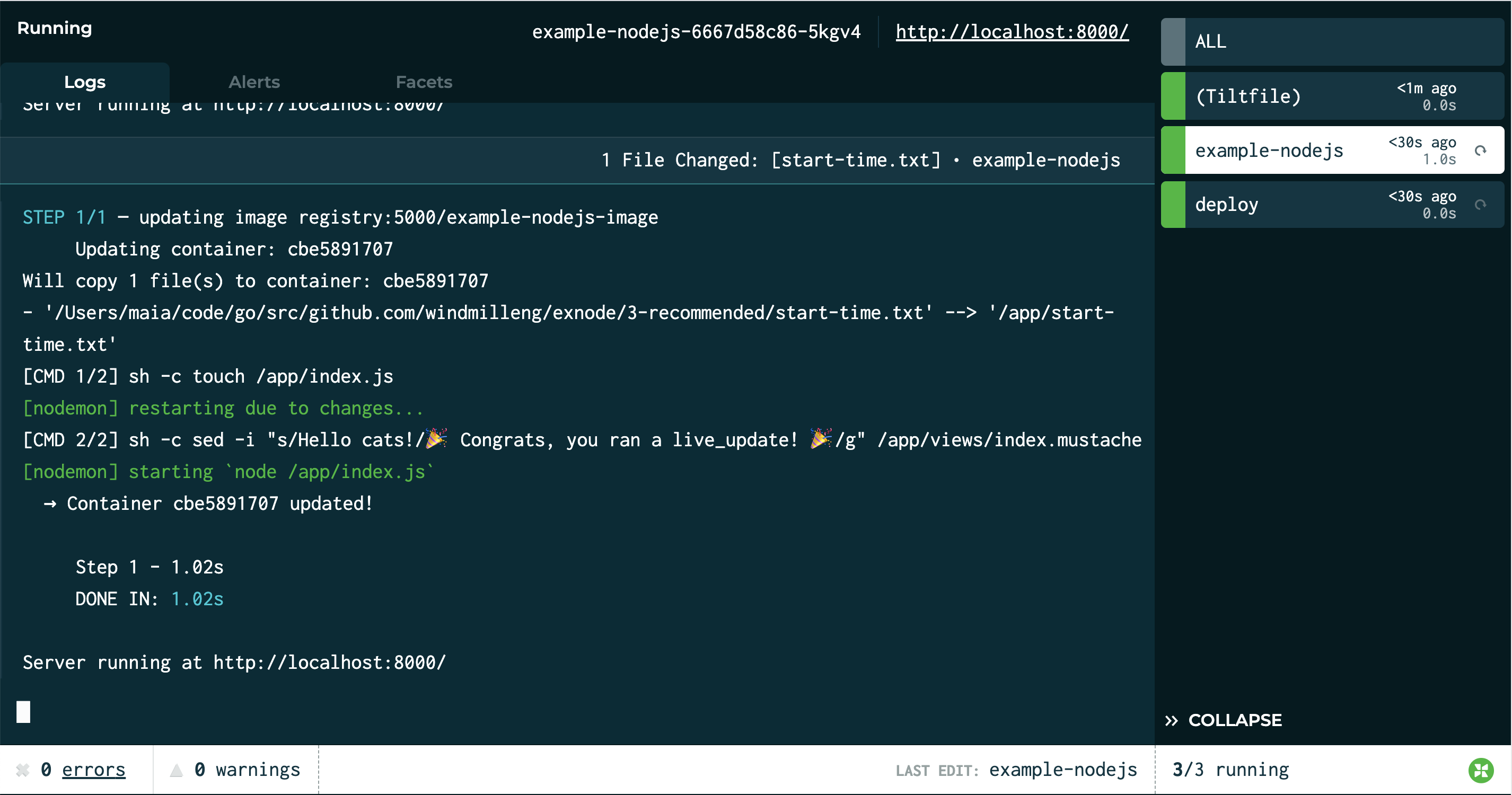Example: NodeJS
The best indicator of a healthy development workflow is a short feedback loop.
Kubernetes is a huge wrench in the works.
Let’s fix this.
In this example, we’re going to take you through a simple “hello world” server written in NodeJS that uses Mustache for templating and Express for serving.
We’ll use Tilt to:
- Run the server on Kubernetes
- Measure the time from a code change to a new process
- Optimize that time for faster feedback
This particular example server doesn’t do much, but it’s useful to confirm that Tilt is working as expected in your environment.
All the code is in this repo:
To skip straight to the fully optimized setup, go to this subdirectory:
Step 0: The Simplest Deployment
Our server is just a few lines long, and all it does is serve us an HTML page:
const express = require('express');
const app = express();
const path = require('path');
app.use(express.static('public'));
app.get('/', (req, res) => {
res.sendFile(path.join(__dirname + '/index.html'));
});
app.listen(8000, () => {
console.log('Server running at http://localhost:8000/');
});
To start this server on Kubernetes, we need three config files:
- A Dockerfile that builds the image
- A Kubernetes deployment that runs the image
- And finally, a Tiltfile that ties them together:
docker_build('example-nodejs-image', '.')
k8s_yaml('kubernetes.yaml')
k8s_resource('example-nodejs', port_forwards=8000)
The first line tells Tilt to build an image with the name example-nodejs-image
in the current directory.
The second line tells Tilt to load the Kubernetes
Deployment
YAML. The image name in the docker_build call must match the container image
reference in the example-nodejs Deployment.
The last line configures port-forwarding so that your server is
reachable at localhost:8000. The resource name in the k8s_resource call
must match the Deployment’s metadata.name in kubernetes.yaml.
Try it! Run:
git clone https://github.com/tilt-dev/tilt-example-nodejs
cd tilt-example-nodejs/0-base
tilt up
Tilt will open a browser showing the web UI, a unified view that shows you app status and logs. Your terminal will also turn into a status box if you’d like to watch your server come up there.
When the server is ready, you will see the status icon turn green. The log pane will display:
Server running at http://localhost:8000/

Step 1: Let’s Add Benchmark Trickery
Before we try to make this faster, let’s measure it.
Using local_resource, you can direct Tilt to execute existing scripts or arbitrary shell commands on your own machine, and manage them from your sidebar like any other Tilt resource. We’re going to use this functionality to benchmark our deployments.
First, we add a local_resource to our
Tiltfile
that records the current time, then kicks off an update.
# Records the current time, then kicks off a server update.
# Normally, you would let Tilt do deploys automatically, but this
# shows you how to set up a custom workflow that measures it.
local_resource(
'deploy',
'date +%s > start-time.txt'
)
k8s_resource('example-nodejs', port_forwards=8000,
resource_deps=['deploy']
)
The local_resource() call creates a local resource named deploy. The second
argument is the command that it runs.
We’ve also modified our server itself to read that start time and display the time elapsed in the HTML it serves:
const fs = require('fs');
let timeSince = 'N/A';
...
app.get('/', (req, res) => {
res.render('index.mustache', {
time: timeSince,
});
});
app.listen(8000, () => {
timeSince = getSecsSinceDeploy();
console.log('Server running at http://localhost:8000/');
});
function getSecsSinceDeploy() {
let curTimeMs = new Date().getTime();
let contents = fs.readFileSync('/app/start-time.txt', 'utf8');
let startTimeMs = parseInt(contents.trim()) / 10**6;
return ((curTimeMs - startTimeMs) / 10**3).toFixed(2)
}
Whenever the app starts up, it calls getSecsSinceDeploy(), calculates the time elapsed, and displays that value in the served webpage. (We’ve added a new dep for this purpose: the templating engine mustache-express.)
See that button next to the deploy resource? Let’s click it and see what happens!

| Approach | Deploy Time1 |
|---|---|
| Naive | 11.31-14.21s |
If you look closely, the elapsed time displayed in the Tilt sidebar is different than the benchmark our app logged. That’s OK! In microservice development, there are many benchmarks we care about—the time to build the image, the time to schedule the process, and the time until the server is ready to serve traffic.
Tilt offers you some default benchmarks, and the tools to capture your own.
Our benchmarks show this is slow. Can we do better?
Step 2: Why Is the Docker Build So Slow?
The first thing I notice when I click “deploy” is a bunch of logs from yarn install; and not just once, but every dang time. This is a hint that we can optimize our Dockerfile to be smarter about caching. With a little rearranging, our new Dockerfile looks like this:
FROM node:10
WORKDIR /app
ADD package.json .
ADD yarn.lock .
RUN yarn install
ADD . .
ENTRYPOINT [ "node", "/app/index.js" ]
Here’s what it looks like when we build with our new Dockerfile:

Hooray, we’re now using the cache instead of running yarn install for every single build.
For more on how to write Dockerfiles for NodeJS apps, check out this guide.
Here’s what our timing looks like now:
| Approach | Deploy Time |
|---|---|
| Naive | 11.31-14.21s |
| Optimized Dockerfile | 3.25-4.12s |
Pretty good! But Tilt has some tricks up its sleeve to make it even faster.
Step 3: Let’s Optimize It Even More
When we make a change to a file, we currently have to build an image, deploy new Kubernetes configs, and wait for Kubernetes to schedule the pod.
With Tilt, we can skip all of these steps, and instead
live_update the pod in place.
The first thing we need to do is change how our app is invoked: we’re going to run it via nodemon, a utility that monitors source files for changes and restarts your app as necessary. In this branch, as reflected in package.json, we’ve already run yarn add --dev nodemon to add nodemon as a dev dependency.
Our new Tiltfile contains the following new code:
# Add a live_update rule to our docker_build
congrats = "🎉 Congrats, you ran a live_update! 🎉"
docker_build('example-nodejs-image', '.',
build_args={'node_env': 'development'},
entrypoint='yarn run nodemon /app/index.js',
live_update=[
sync('.', '/app'),
run('cd /app && yarn install', trigger=['./package.json', './yarn.lock']),
# if all that changed was start-time.txt, make sure the server
# reloads so that it will reflect the new startup time
run('touch /app/index.js', trigger='./start-time.txt'),
# add a congrats message!
run('sed -i "s/Hello cats!/{}/g" /app/views/index.mustache'.
format(congrats)),
])
We’ve added some new parameters to docker_build that tell the container to use nodemon:
- The
entrypointparameter overrides theENTRYPOINTspecified in the Dockerfile; now when the container executes, it will runyarn run nodemon /app/index.js - The
build_argsparameter corresponds to this Dockerfile change:# Default value; will be overridden by build_args, if passed ARG node_env=production ENV NODE_ENV $node_envTogether, these changes mean that when we build this Dockerfile via this Tiltfile, we set the env var
$NODE_ENV=development, and ouryarn installcall will install dev dependencies.
The other new addition to our Tiltfile is the live_update argument to docker_build, which enables super-fast in-place updates of your app. When a live_update is triggered, Tilt will, in order:
- Sync the code from the current directory (
.) into the container at directory/app - IF
package.jsonoryarn.lockhas changed, runyarn install - Poke
index.jsif necessary to make sure that nodemon reloads the server - Congratulate you on finishing this guide!
Let’s see what this new configuration looks like in action:

Tilt and nodemon together updated the container in less than two seconds!
Our Recommendation
Final Score
| Approach | Deploy Time |
|---|---|
| Naive | 11.31-14.21s |
| Optimized Dockerfile | 3.25-4.12s |
| With live_update | 1.1-1.8s |
You can try the server here:
This is a very simple example, but we hope it gives you a good starting point for running your NodeJS app via Tilt!
Further Reading
CI
Once you’re done configuring your project, set up a CI test to ensure
your setup doesn’t break! In the example repo, CircleCI uses
ctlptl to create a single-use Kubernetes
cluster. The test script invokes tilt ci. The tilt ci command deploys all
services in a Tiltfile and exits successfully if they’re healthy.
Other sample JS projects:
- Tilt Avatars, a microservice app with a Vite frontend.
- Pixeltilt, a microservice app with a NextJS frontend. Uses both server-side and client-side rendering.
- Tiltfile exposing the NodeJS debugger port
- Demo React app
- Demo Vue.js app
- abc123 is a mini microservice app with a NodeJS server called
letters - Servantes, our multi-language microservice demo app, contains a NodeJS service called
spoonerisms
Examples in other languages:
-
Tilt’s first deployment of a service takes a few seconds longer than subsequent ones, due to some behind-the-scenes setup. Measurements in this guide focus on non-initial builds. ↩